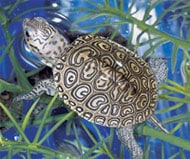Description:
One of the most unique North American turtles, the diamondback terrapin is in need of conservation. Terrapins, although not federally protected, are still protected in many states, which means keeping them is either illegal or allowed only with a permit. Check your state and local wildlife laws if you plan to acquire a terrapin. Captive-bred specimens are always the way to go. Diamondback terrapins are one of the most physically variable turtles, having different shell patterns, skin colors, markings and shapes, even among specimens within the same subspecies. Another trait that distinguishes them is their large hindfeet, which gives them greater mobility in strong tidal currents and undertows. Diamondback terrapins are medium-sized turtles that have a grayish, nearly black carapace. Their plastron is usually a yellowish or greenish gray. With white skin that's patterned in black and gray, these turtles have markings that are as unique as human fingerprints. An adult terrapin needs at least a 60-gallon tank with a large basking area. Basking sites can be built using slate rock, river rock, etc., and should have a heat lamp to keep temperatures in the mid 80s Fahrenheit. They also require a UVB light and a day-night cycle that approximates the current season. The water temperature should be approximately 78 degrees. Wild diamondback terrapins are found in brackish habitats, and providing captive terrapins with saltwater is important. Add one-fourth cup of salt per 20 gallons of water; commercial kits are also available at tropical fish stores. Good filtration is essential to maintaining their health. In nature, diamondback terrapins are predominantly carnivorous, eating a wide range of salt marsh mollusks and crustaceans, as well as insects and fish. In captivity, however, these turtles usually accept commercial turtle food, insects and fish. For variety, offer smelt or cooked shrimp (not too often), but avoid freshwater crayfish. Adult terrapins should be fed daily, while juveniles need to be fed several times a day. Good sources of calcium for terrapins are coral (as substrate), calcium blocks and cuttlebone (such as that sold for birds). Diamondback terrapins tend to be messy eaters, necessitating more water changes or feeding them in a separate location.
Habitat:
Brackish water, salt marshes and lagoons.
Range:
The Atlantic and Gulf coasts from New York to Texas.
Scientific Name: Malaclemys terrapin
Species Group: turtle
Family: Emydidae
Size: Male terrapins are about 5 inches long; females are usually 9 inches.
Level: intermediate
Weight: N/A
Dangerous: No



